surfacescraper
Tenderfoot
I had to do more than scraping surface to get to this thing:
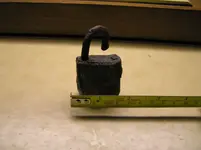
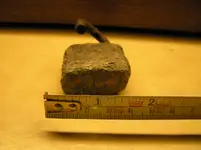
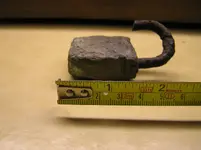
The body is solid lead. The shackle has been cut and I can kind of make out the letters "H...A...uh, R...". So, the shackle is probably marked "HARDENED" and made of steel. Note no place for a key. The item is not a padlock and is constructed of lead metal. I think, most likely a crimp type security seal. A seal like they don't make today. Padlock shaped security items are now sold, but made of plastic.
The thing is old. I found the seal about one foot in ground here (arrow points to location):
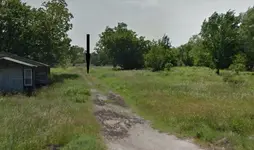
At first I thought the road was only a driveway for the abandoned house located left side of picture. However, if you continue down the driveway the road turns to the left and continues for a quarter of a mile to end at extensive ruins...some of which I show here:
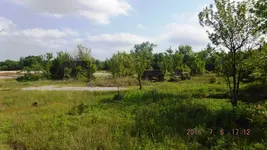
The ruins are what is left of a lead and zinc ore processing plant. The ruins of many of these plants remain in this area...part of the tri-state mining district. So, the driveway was also used as a path from mine to processing plant. I'm thinking may have been used to security seal something used for mining or milling ore...dangerous?...dynamite? Okay, but the lead item was located at the boundary between chat and what would normally be ground surface. "Chat" is the name given to aquarium gravel size stone and what remains after extracting lead and zinc from ore. Based on my diggings--this area of northeast Oklahoma (into Kansas and Missouri) seems to be covered with an eight inch to twelve inch layer of chat. I'm talking about flat ground...forget about the huge tailings piles. Assuming the lead item did not sink through the chat to soil level, the thing was left on the ground before mining operations. I would estimate this would have to be before 1910.
Even though my dug up object is old and ugly and beat up, it represents one of the things I really like about metal detecting--the story imagined for a found object.
Oh yes, on the way to the ore processing ruins is located this:
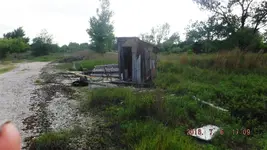
It did not take a whole lot of research to figure out the purpose of the structure.
Rusty



The body is solid lead. The shackle has been cut and I can kind of make out the letters "H...A...uh, R...". So, the shackle is probably marked "HARDENED" and made of steel. Note no place for a key. The item is not a padlock and is constructed of lead metal. I think, most likely a crimp type security seal. A seal like they don't make today. Padlock shaped security items are now sold, but made of plastic.
The thing is old. I found the seal about one foot in ground here (arrow points to location):

At first I thought the road was only a driveway for the abandoned house located left side of picture. However, if you continue down the driveway the road turns to the left and continues for a quarter of a mile to end at extensive ruins...some of which I show here:

The ruins are what is left of a lead and zinc ore processing plant. The ruins of many of these plants remain in this area...part of the tri-state mining district. So, the driveway was also used as a path from mine to processing plant. I'm thinking may have been used to security seal something used for mining or milling ore...dangerous?...dynamite? Okay, but the lead item was located at the boundary between chat and what would normally be ground surface. "Chat" is the name given to aquarium gravel size stone and what remains after extracting lead and zinc from ore. Based on my diggings--this area of northeast Oklahoma (into Kansas and Missouri) seems to be covered with an eight inch to twelve inch layer of chat. I'm talking about flat ground...forget about the huge tailings piles. Assuming the lead item did not sink through the chat to soil level, the thing was left on the ground before mining operations. I would estimate this would have to be before 1910.
Even though my dug up object is old and ugly and beat up, it represents one of the things I really like about metal detecting--the story imagined for a found object.
Oh yes, on the way to the ore processing ruins is located this:

It did not take a whole lot of research to figure out the purpose of the structure.
Rusty
Amazon Forum Fav 👍
Upvote
10




